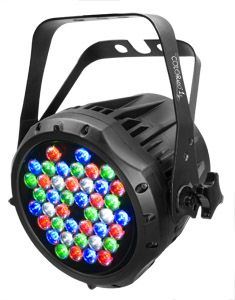Tech Talk: Learn How to Measure the Lux
Posted on November 28, 2010Written by Mike Graham, product manager for CHAUVET Professional
LED technology brought many advancements to the lighting world. The ability to use 30 COLORado 1 units off of one 20Amp circuit is amazing and was unheard of until a few short years ago. Who would have thought that we could stop changing lamps and cutting gel for PAR cans? LED technology has left us with a few problems though, one of which is measuring the brightness of its light products.
1. Did you know? While lux and lumen readings depend on seeing a full spectrum of visible light, LED fixtures do not produce the full spectrum. They only produce spikes of color. Those spikes reside in the red, green and blue zones of the color spectrum. This causes light meters to give inaccurate readings due to the missing information.
 2. Know how to read the lux. When comparing the lux of a PAR 56 MFL and a COLORado 1, for example, the problem becomes apparent. At full white, the PAR 56 is 17,800 lux at 1m, while the COLORado 1 with a 15-degree lens is 11,862 lux. The difference can be attributed to the missing portions of the spectrum. When you look at individual color, the truth comes out. In red, for example, the COLORado 1 is 4,045 lux. The PAR 56 is 2,560 lux. Now we can start to see the misleading lux readings. The LED fixture is going to be brighter in the red, green and blue because those are native colors to the light. The PAR 56 must have a gel added to create these colors.
2. Know how to read the lux. When comparing the lux of a PAR 56 MFL and a COLORado 1, for example, the problem becomes apparent. At full white, the PAR 56 is 17,800 lux at 1m, while the COLORado 1 with a 15-degree lens is 11,862 lux. The difference can be attributed to the missing portions of the spectrum. When you look at individual color, the truth comes out. In red, for example, the COLORado 1 is 4,045 lux. The PAR 56 is 2,560 lux. Now we can start to see the misleading lux readings. The LED fixture is going to be brighter in the red, green and blue because those are native colors to the light. The PAR 56 must have a gel added to create these colors.
3. Conclusion. The moral of the story is to be careful when looking at the lux readings of LED fixtures. Lux readings are not the whole story and most likely were taken when the fixture had all of the LEDs on. When you have clients who demand the old PAR can because the lux is higher, let them know that it’s not all about the lux – their eyes should be the judge.
